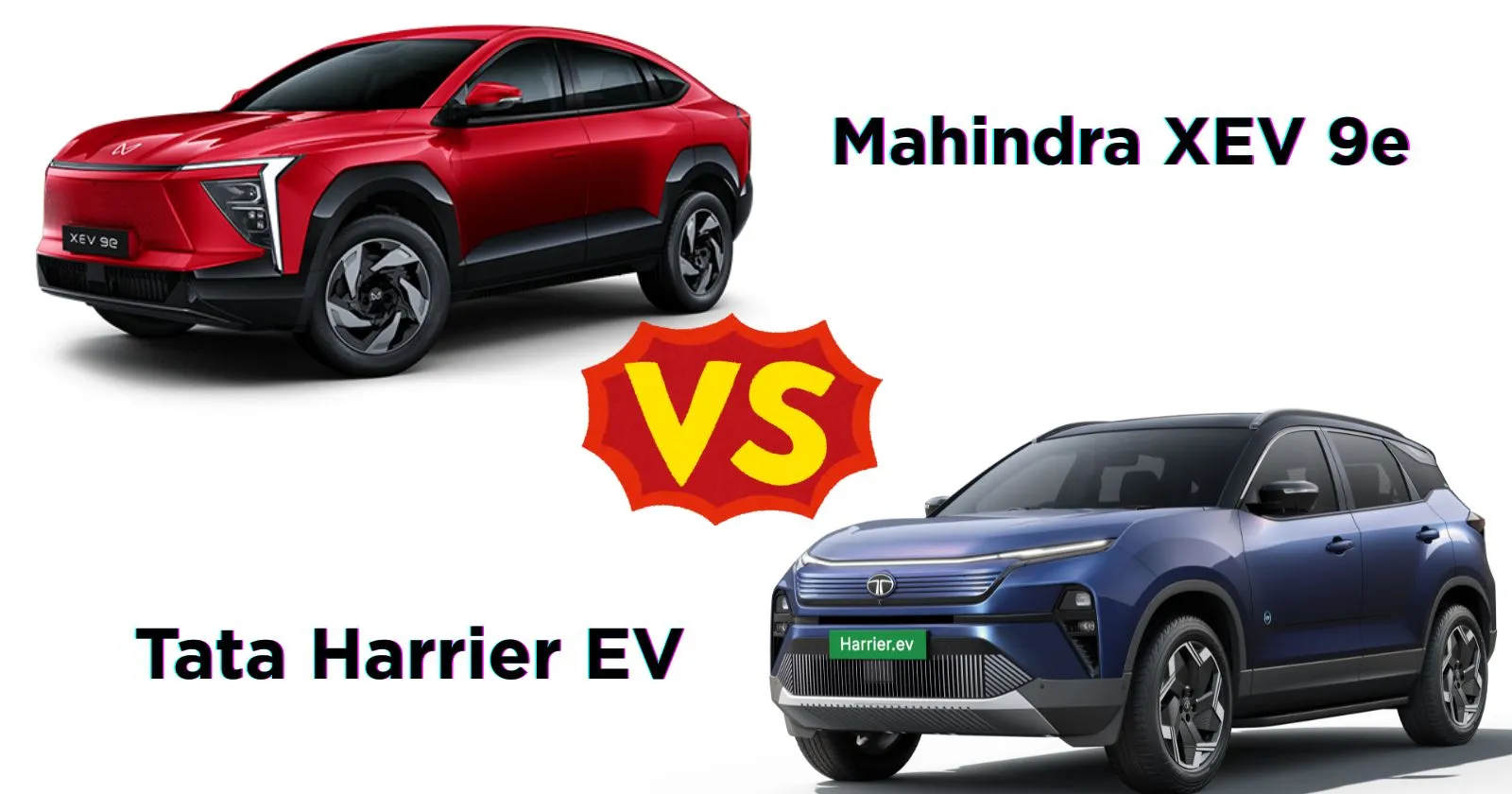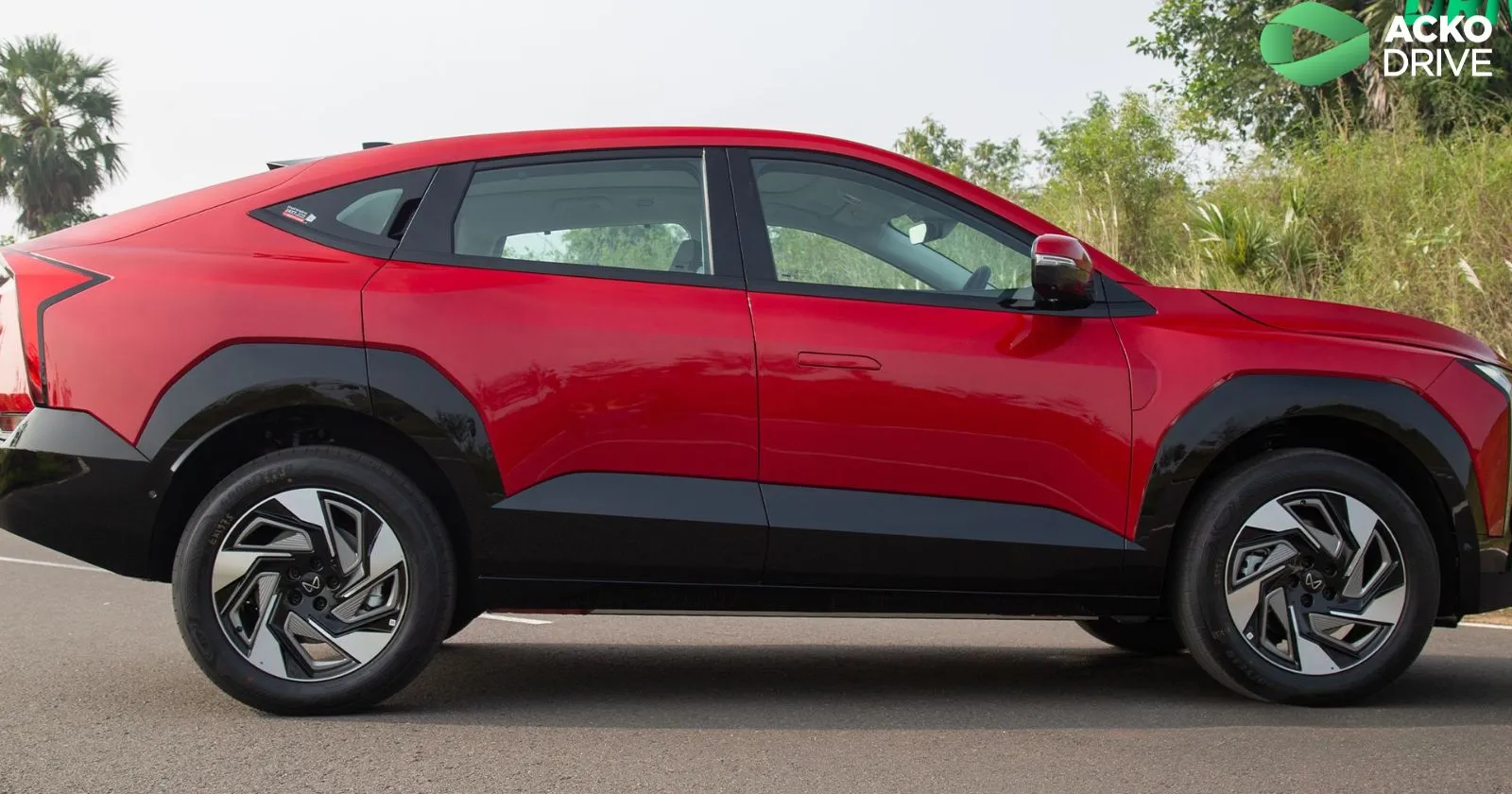
Here’s how the two cars stack up against each other.

Share Post

Here’s how the two cars stack up against each other.
With the arrival of the all-electric Tata Harrier EV, Tata Motors is targeting dominance in the premium electric SUV segment. Its direct rival is Mahindra’s XEV 9e. Here’s how the two cars stack up against each other.
The Mahindra XEV 9e is significantly longer than the Tata Harrier EV by 182 mm, while the Harrier EV takes the lead in width (+225 mm) and height (+46 mm). The XEV 9e's slightly longer wheelbase (2,775 mm vs 2,741 mm) makes for more comfortable rear seating.

Tata Harrier EV | Mahindra XEV 9e | |
|---|---|---|
| Length | 4607 mm | 4,789 mm |
| Width | 2132 mm | 1,907 mm |
| Height | 1740 mm | 1,694 mm |
| Wheelbase | 2741 mm | 2,775 mm |
| Boot Space | 502L | 663L |
| Ground Clearance | 205 mm | 207 mm |

While both models provide real-world ranges above 500 km, the Mahindra XEV 9e takes the edge on paper with its 79 kWh battery and a claimed 656 km range, compared to the Harrier EV’s maximum 75 kWh battery and 622 km range.
Tata Harrier EV | Mahindra XEV 9e | |
|---|---|---|
| Battery Size | 65 kWh/ 75 kWh | 59 kWh/ 79 kWh |
| Max Power | 235 bhp (65)/235 bhp (75) AWD- 156 bhp (Front motor)/ 235 bhp (Rear motor) | 228 bhp/ 282 bhp |
| Peak Torque | 315 Nm/ 315 Nm 504 Nm (AWD) | 380 Nm |
| Claimed Range | 538 km/627 km/ 622 km (AWD) | 542 km (59)/ 656 km (79) |
| 0-100 kmph | 6.3 seconds | 6.8 seconds |
| Drivetrain | RWD/AWD | RWD |
Both SUVs support 7.2 kW AC charging. The Harrier EV charges slightly faster on AC (10.7 hours vs 11.7 hours, from 10%–100%). In terms of DC fast charging, XEV 9e again has a slight edge, charging from 20% to 80% in just 20 minutes with a 180 kW fast charger, compared to 25 minutes required for the Harrier EV using a 120 kW charger.

Tata Motors’ EZ Charge network under the Tata Power umbrella covers 530 cities and towns, offering more than 100,000 home chargers, over 5,500 public, semi-public, and fleet charging points, and 1,100 bus charging stations across India.
On the other hand, over 1,100 Mahindra-connected EV charging stations are available nationwide, accessible through collaborations (notably with Adani Total Energies E-Mobility Ltd) and via the Bluesense+ app.
Both SUVs are rich in features, including autonomous parking, panoramic sunroof, multi-zone climate control, and Level 2 ADAS.


For most buyers, Tata Harrier EV variants (especially Adventure 65 and Fearless Plus 75) have a stronger value-for-money proposition, with more equipment and tech per rupee than Mahindra XEV 9e’s comparably priced trims. Mahindra’s advantage shows only at the very top, for those who want maximum battery and are willing to pay a premium.
Variant | Price (ex-showroom, India) |
|---|---|
| Adventure 65 | ₹21.49 lakh |
| Adventure S 65 | ₹21.99 lakh |
| Fearless Plus 65 | ₹23.99 lakh |
| Fearless Plus 75 | ₹24.99 lakh |
| Empowered 75 | ₹27.49 lakh |
| Empowered 75 Stealth | ₹28.24 lakh |
| Empowered 75 AWD | ₹28.99 lakh |
| Empowered 75 AWD Stealth | ₹29.74 lakh |
Variant | Price (ex-showroom, India) |
|---|---|
| Pack 1 | ₹21.90- ₹22.65 lakh |
| Pack 2 | ₹24.90- ₹25.40 lakh |
| Pack 2 (79 kWh) | ₹26.50- 27.25 lakh |
| Pack 3 | ₹27.90- ₹31.25 lakh |
Tata Motors began production of the Harrier EV at its Pune plant earlier this month, with customer deliveries scheduled to start later in July. While the company has not disclosed total booking numbers, it received over 10,000 bookings within just 24 hours of opening pre-orders on July 2.

Mahindra began deliveries of the XEV 9e Pack Three on March 20, and, combined with the BE 6, has sold over 10,000 units so far, though individual model sales figures have not been disclosed. Deliveries for Pack 2 are set to start later this month, with Pack 1 scheduled to follow in August 2025.
Both the Tata Harrier EV and Mahindra XEV 9e offer a strong suite of safety features, including Level 2 ADAS, electronic stability control, ISOFIX mounts, and a 360-degree camera system. However, the Harrier EV has an edge by providing seven airbags as standard across all variants, while the XEV 9e includes six airbags as standard, reserving seven airbags only for its top-spec model.

The Harrier EV stands out with added features such as a knee airbag, Acoustic Vehicle Alert System (AVAS), a transparent under-car camera, all-wheel disc brakes with a wiping function, and an SOS call feature. The Mahindra XEV 9e, meanwhile, offers practical additions like an air purifier, auto-defogging windshield, and a comprehensive 360-degree live view and recording system.
In terms of Bharat NCAP crash rating, neither vehicle has an advantage, as both secured a 5-star rating for adult and child safety at Bharat NCAP.
Tata Harrier EV | Mahindra XEV 9e | |
|---|---|---|
| Pros | 1. Vehicle-to-Vehicle (V2V), Vehicle-to-Load (V2L) charging 2. transparent 360-degree camera 3. All-Wheel-Drive (AWD) variants, six terrain-focused drive modes. | 1. Claimed highest range in the segment with a 79 kWh battery offering up to 656 km 2. Significantly larger boot (663L) and frunk (150L) space 3. Slightly quicker DC fast charging |
| Cons | 1. Less overall driving range 2. Smaller boot and frunk space (502L + 35L) 3. DC fast charging is a bit slower | 1. Lacks AWD configuration 2. No V2V/V2L 3. Narrower and lower overall body may reduce cabin spaciousness |
Auto Sales December 2025: Ashok Leyland Reports 27% YoY, 18% MoM Growth
Acko Drive Team 1 Jan, 2026, 2:01 PM IST
Maruti Suzuki To Defer Price Increase To End Of January Amidst Strong Momentum For Small Cars
Acko Drive Team 1 Jan, 2026, 1:23 PM IST
Auto Sales December 2025: Kia Registers 15% YoY Growth In CY2025, Records Best-Ever December Volumes
Acko Drive Team 1 Jan, 2026, 12:36 PM IST
Tata Motors Delivers Strong Q3 FY26 as PVs, CVs Sales Gain Momentum
Acko Drive Team 1 Jan, 2026, 12:24 PM IST
Auto Sales December 2025: Hyundai Achieves 6.6% YoY Growth
Acko Drive Team 1 Jan, 2026, 12:24 PM IST
Looking for a new car?
We promise the best car deals and earliest delivery!
